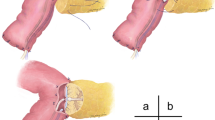Abstract
Background
Pancreaticojejunal anastomotic leakage remains a major complication after pancreatoduodenectomy, and various means of preventing pancreatic leakage have been studied over the past few decades. The purpose of this study was to determine whether closed suction drainage provided a better option than gravity drainage in pancreaticojejunostomy.
Methods
Between 2004 and 2006, a total of 110 patients who underwent pancreaticojejunostomy at our institute were enrolled in this prospective randomized pilot study. Fifty-five patients were allocated to the closed suction drainage (CD) group and 55 to the gravity drainage (GD) group. In each patient a polyethylene pediatric feeding tube was inserted into the remnant pancreatic duct across a duct-to-mucosa type pancreaticojejunostomy and totally externalized. The tube was then connected to the aspiration bag of a Jackson–Pratt drain to generate negative pressure or to a bile bag for natural drainage. Pancreatic fistulas were defined and graded as A, B, or C according to the international study group for pancreatic fistulas (ISGPF) criteria.
Results
No differences were found between the GD and CD groups in age, sex distribution, or diagnosis. A pancreatic fistula occurred in 24 patients (43.6%) in the GD group and in 14 (25.5%) in the CD group (P = 0.045). In the GD group, grade B and C fistula occurred in 6 patients (10.9%), whereas in the CD group, this occurred in 5 patients (9.1%).
Conclusion
In this study, temporary external drainage of the pancreatic duct with closed suction drainage significantly reduced the incidence of grade A pancreatic fistula. A follow-up randomized prospective multicenter study has been initiated.


Similar content being viewed by others
References
Tran K, Van Eijck C, Di Carlo V, Hop WC, Zerbi A, Balzano G, et al. Occlusion of the pancreatic duct versus pancreaticojejunostomy: a prospective randomized trial. Ann Surg. 2002;236:422–8.
Lillemoe KD, Cameron JL, Kim MP, Campbell KA, Sauter PK, Coleman JA, et al. Does fibrin glue sealant decrease the rate of pancreatic fistula after pancreaticoduodenectomy? Results of a prospective randomized trial. J Gastrointest Surg. 2004;8:766–72.
Winter JM, Cameron JL, Campbell KA, Chang DC, Riall TS, Schulick RD, et al. Does pancreatic duct stenting decrease the rate of pancreatic fistula following pancreaticoduodenectomy? Results of a prospective randomized trial. J Gastrointest Surg. 2006;10:1280–90.
Yeo CJ, Cameron JL, Maher MM, Sauter PK, Zahurak ML, Talamini MA, et al. A prospective randomized trial of pancreaticogastrostomy versus pancreaticojejunostomy after pancreaticoduodenectomy. Ann Surg. 1995;222:580–8.
Butturini G, Daskalaki D, Molinari E, Scopelliti F, Casarotto A, Bassi C. Pancreatic fistula: definition and current problems. J Hepatobiliary Pancreat Surg. 2008;15:247–51.
Hamanaka Y, Suzuki T. Total pancreatic duct drainage for leakproof pancreatojejunostomy. Surgery. 1994;115:22–6.
Mok KT, Wang BW, Liu SI. Management of pancreatic remnant with strategies according to the size of pancreatic duct after pancreaticoduodenectomy. Br J Surg. 1999;86:1018–9.
Poon RT, Fan ST, Lo CM, Ng KK, Yuen WK, Yeung C, et al. External drainage of pancreatic duct with a stent to reduce leakage rate of pancreaticojejunostomy after pancreaticoduodenectomy: a prospective randomized trial. Ann Surg. 2007;246:425–33.
Lee SE, Yang SH, Jang JY, Kim SW. Pancreatic fistula after pancreaticoduodenectomy: A comparison between the two pancreaticojejunostomy methods for approximating the pancreatic parenchyma to the jejunal seromuscular layer: Interrupted vs continuous stitches. World J Gastroenterol. 2007;13:5351–6.
Bassi C, Dervenis C, Butturini G, Fingerhut A, Yeo C, Izbicki J, et al. Postoperative pancreatic fistula: an international study group (ISGPF) definition. Surgery. 2005;138:8–13.
Kim SW, Youk EG, Park YH. Comparison of pancreatogastrostomy and pancreatojejunostomy after pancreatoduodenectomy performed by one surgeon. World J Surg. 1997;21:640–3.
Park YC, Kim SW, Jang JY, Ahn YJ, Park YH. Factors influencing delayed gastric emptying after pylorus-preserving pancreatoduodenectomy. J Am Coll Surg. 2003;196:859–65.
Watanabe M, Usui S, Kajiwara H, Nakamura M, Sumiyama Y, Takada T, et al. Current pancreatogastrointestinal anastomotic methods: results of a Japanese survey of 3109 patients. J Hepatobiliary Pancreat Surg. 2004;11:25–33.
Smith CD, Sarr MG, van Heerden JA. Completion pancreatectomy following pancreaticoduodenectomy: clinical experience. World J Surg. 1992;16:521–4.
Hamanaka Y, Nishihara K, Hamasaki T, Kawabata A, Yamamoto S, Tsurumi M, et al. Pancreatic juice output after pancreatoduodenectomy in relation to pancreatic consistency, duct size, and leakage. Surgery. 1996;119:281–7.
Okamoto A, Tsuruta K. Fistulation method: simple and safe pancreaticojejunostomy after pancreatoduodenectomy. Surgery. 2000;127:433–8.
Okabayashi T, Kobayashi M, Nishimori I, Sugimoto T, Onishi S, Hanazaki K. Risk factors, predictors and prevention of pancreatic fistula formation after pancreatoduodenectomy. J Hepatobiliary Pancreat Surg. 2007;14:557–63.
Popiela T, Kedra B, Sierzega M, Gurda A. Risk factors of pancreatic fistula following pancreaticoduodenectomy for periampullary cancer. Hepatogastroenterology. 2004;51:1484–8.
Fernández-del Castillo C, Rattner DW, Warshaw AL. Standards for pancreatic resection in the 1990s. Arch Surg. 1995;130:295–9.
Forrest JF, Longmire WP Jr. Carcinoma of the pancreas and periampullary region. Ann Surg. 1979;189:129–38.
Biehl T, Traverso LW. Is stenting necessary for a successful pancreatic anastomosis? Am J Surg. 1992;163:530–2.
Roder JD, Stein HJ, Bottcher KA, Busch R, Heidecke CD, Siewert JR. Stented versus nonstented pancreaticojejunostomy after pancreatoduodenectomy: a prospective study. Ann Surg. 1999;229:41–8.
Ohwada S, Tanahashi Y, Ogawa T, Kawate S, Hamada K, Tago KI, et al. In situ vs ex situ pancreatic duct stents of duct-to-mucosa pancreaticojejunostomy after pancreaticoduodenectomy with Billroth I-type reconstruction. Arch Surg. 2002;137:1289–93.
Langrehr JM, Bahra M, Jacob D, Glanemann M, Neuhaus P. Prospective randomized comparison between a new mattress technique and Cattell (duct-to-mucosa) pancreaticojejunostomy for pancreatic resection. World J Surg. 2005;29:1111–9.
Acknowledgments
This study was supported by the National R&D Program for Cancer Control, Ministry of Health & Welfare, Republic of Korea. (# 0520320) and Seoul National University Hospital research program (04-2006-0380).
Author information
Authors and Affiliations
Corresponding author
Additional information
S. E. Lee and Y.-J. Ahn contributed equally in this work.
This study was registered at http://www.clinicaltrials.gov/ (Clinical Trials) and the registered number was Seoul National University Hospital protocol record H-0612-018-191.
About this article
Cite this article
Lee, S.E., Ahn, YJ., Jang, JY. et al. Prospective randomized pilot trial comparing closed suction drainage and gravity drainage of the pancreatic duct in pancreaticojejunostomy. J Hepatobiliary Pancreat Surg 16, 837–843 (2009). https://doi.org/10.1007/s00534-009-0171-x
Received:
Accepted:
Published:
Issue Date:
DOI: https://doi.org/10.1007/s00534-009-0171-x




